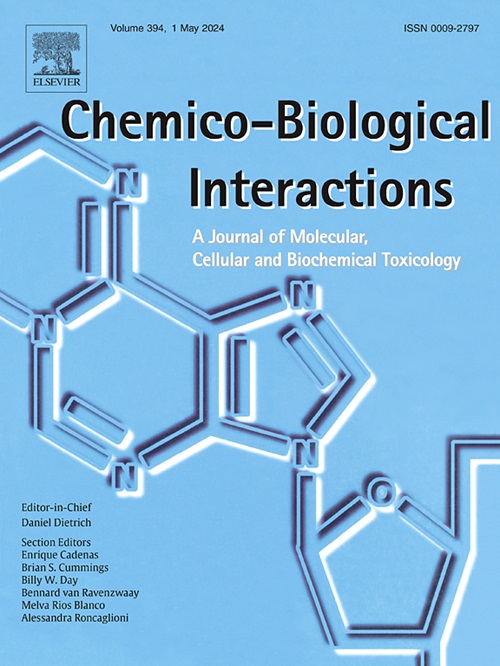Fatty acid binding protein 4 regulates doxorubicin-induced renal injury via mediating lipid metabolism and apoptosis
IF 4.7
2区 医学
Q1 BIOCHEMISTRY & MOLECULAR BIOLOGY
引用次数: 0
Abstract
Doxorubicin(DOX) is an anthracycline chemotherapeutic drug used in the treatment of a wide range of tumors. However, the nephrotoxicity has limited the clinical application of DOX. Fatty acid-binding protein 4 (FABP4), a key adipokine mainly expressed in adipocytes, is strongly associated with kidney dysfunction and kidney disease. This study aims to investigate the role of FABP4 in DOX-induced nephrotoxicity. In vivo experiments, the mice were divided into 4 groups randomly: CON group, DOX group, 4T1 group, and 4T1 + DOX group respectively. DOX was given by intraperitoneal injection at a dose of 15 mg/kg. The kidney function indicators, the morphology and lipid deposition in renal tissues and the preliminary mechanism were assessed. In vitro experiment, HK-2 cell was used to detect DOX-induced kidney cell injury with or without BMS309403. DOX caused renal dysfunction in both DOX group and 4T1 + DOX group, with a more severe kidney injury in DOX group. DOX also induced kidney lipid deposition, glycerophospholipids metabolism dysfunction, apoptosis accompanied by increased FABP4 and decreased Peroxisome Proliferator Activated Receptor- γ (PPAR-γ) levels in the kidney tissues. The decreased cell viability, increased apoptotic ratio, elevated protein levels of apoptosis and the lipid deposition caused by DOX were all alleviated by BMS309403. FABP4 mediated DOX induced kidney damage in normal mice and tumor-bearing mice by lipid metabolism disorders and cell apoptosis. This study may enhance the clinical management of DOX-induced kidney injury and provide new therapeutic targets and preventive strategies for the clinical application of DOX.
脂肪酸结合蛋白4通过介导脂质代谢和细胞凋亡调控阿霉素所致肾损伤
阿霉素(DOX)是一种蒽环类化疗药物,用于治疗多种肿瘤。然而,肾毒性限制了DOX的临床应用。脂肪酸结合蛋白4 (Fatty acid binding protein 4, FABP4)是一种主要表达于脂肪细胞的关键脂肪因子,与肾脏功能障碍和肾脏疾病密切相关。本研究旨在探讨FABP4在dox诱导的肾毒性中的作用。体内实验将小鼠随机分为4组:CON组、DOX组、4T1组、4T1 + DOX组。DOX以15mg /kg的剂量腹腔注射。观察大鼠肾功能指标、肾组织形态及脂质沉积情况,并初步探讨其作用机制。体外实验采用HK-2细胞检测添加或不添加BMS309403的dox诱导肾细胞损伤。DOX组和4T1 + DOX组均引起肾功能不全,且DOX组肾损伤更严重。DOX还诱导肾脂质沉积、甘油磷脂代谢功能障碍、凋亡,并伴有肾组织中FABP4升高和过氧化物酶体增殖物激活受体-γ (PPAR-γ)水平降低。BMS309403可减轻DOX引起的细胞活力下降、凋亡率升高、凋亡蛋白水平升高和脂质沉积。FABP4介导的DOX通过脂质代谢紊乱和细胞凋亡诱导正常小鼠和荷瘤小鼠肾损伤。本研究可加强DOX致肾损伤的临床管理,为DOX的临床应用提供新的治疗靶点和预防策略。
本文章由计算机程序翻译,如有差异,请以英文原文为准。
求助全文
约1分钟内获得全文
求助全文
来源期刊
CiteScore
7.70
自引率
3.90%
发文量
410
审稿时长
36 days
期刊介绍:
Chemico-Biological Interactions publishes research reports and review articles that examine the molecular, cellular, and/or biochemical basis of toxicologically relevant outcomes. Special emphasis is placed on toxicological mechanisms associated with interactions between chemicals and biological systems. Outcomes may include all traditional endpoints caused by synthetic or naturally occurring chemicals, both in vivo and in vitro. Endpoints of interest include, but are not limited to carcinogenesis, mutagenesis, respiratory toxicology, neurotoxicology, reproductive and developmental toxicology, and immunotoxicology.

 求助内容:
求助内容: 应助结果提醒方式:
应助结果提醒方式:


